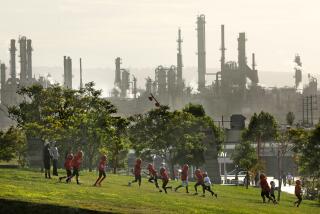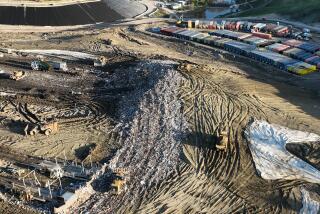Fumes at Fairfax Bank Branch Linked to Old Gas Spill : Hazardous waste: Geological tests find the fumes are not related to underground methane deposits that have led to fires and explosions.
- Share via
The gas fumes that forced Wells Fargo to close its bank branch on Fairfax Avenue apparently came from an old gasoline spill, not underground methane deposits as first suspected, according to a report from a geological testing company.
“We have no conclusive evidence at this point, but there is a strong suspicion that gasoline is part of the problem,” said Wells Fargo spokeswoman Kathy Shilkret.
The Wells Fargo bank branch, which will reopen Friday in a trailer in the parking lot, was abandoned after a potentially dangerous concentration of gas was detected in a wall panel Nov. 9.
Experts first suspected methane as the source of the fumes, because the building is located less than a mile from the site of a methane explosion and fire that injured 21 people at the Ross Dress for Less store on 3rd Street on March 24, 1985.
A buildup of methane was also to blame for a February, 1989, scare that saw water, gas and mud spew into the air from a rupture in a parking lot near the Gilmore Bank in the Farmers Market, which is nearby.
In the latest incident, a potentially explosive concentration of gas was found in a wall panel. The bank, located next to a gas station at the corner of Beverly Boulevard, was immediately closed. But a lab report based on samples taken from the wall was not available until recently.
“Up until the analysis, all they knew was that it was an explosive vapor,” said city geologist Joseph Cobarrubias. “But the analysis looked like refined gasoline vapor.”
With suspicion pointing to the Arco gas station next door, the Los Angeles City Fire Department ordered World Oil Co., which operates the station under contract, to check for possible leaks.
“We have tested our tanks and associated piping, and the whole thing tested tight, which indicates there was no leakage,” said Mark Blair, director of environmental affairs for World Oil.
But an examination of company records showed that there was a spill of gasoline when workers hit a pipe during construction about 10 years ago, he said.
“Our records indicate that most of the gasoline was recovered at that time,” he said. “It was fairly localized and contained.”
With a small but steady flow of vapor still entering the abandoned building through an underground electrical conduit, responsibility for abating the problem has not yet been assigned, said a spokeswoman for City Councilman Zev Yaroslavsky, who represents the area.
She said the matter will be discussed at a meeting of the City Council’s Public Safety Committee in early February.
“It appears to be old, old gasoline that has been in the ground for many years,” said Katherine McDonald, Yaroslavsky’s aide. “The remaining problem is that the old gasoline has to be cleaned up.”
Meanwhile, plans call for workers to install sensors, vents and alarm systems to bring the original building in line with city requirements, Shilkret said.
The parking lot has been fitted with 800 feet of underground piping designed to vent any buildup of potentially dangerous vapors.
“Our real estate people were looking at all sorts of buildings but they didn’t want to get out of that building because the lease was good,” she said.
“It hinged on whether or not this was salvageable, and the engineers and geologists said that changes could be made so that they could safely reopen the building,” she said.
The temporary quarters in the trailer will offer all banking services except for safety deposit boxes, which are available at a building on Larchmont Boulevard.
More to Read
Sign up for Essential California
The most important California stories and recommendations in your inbox every morning.
You may occasionally receive promotional content from the Los Angeles Times.










